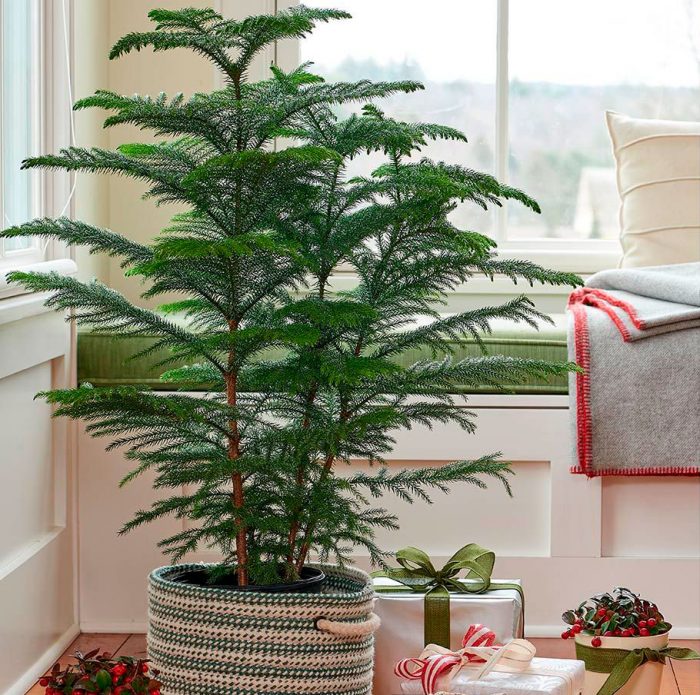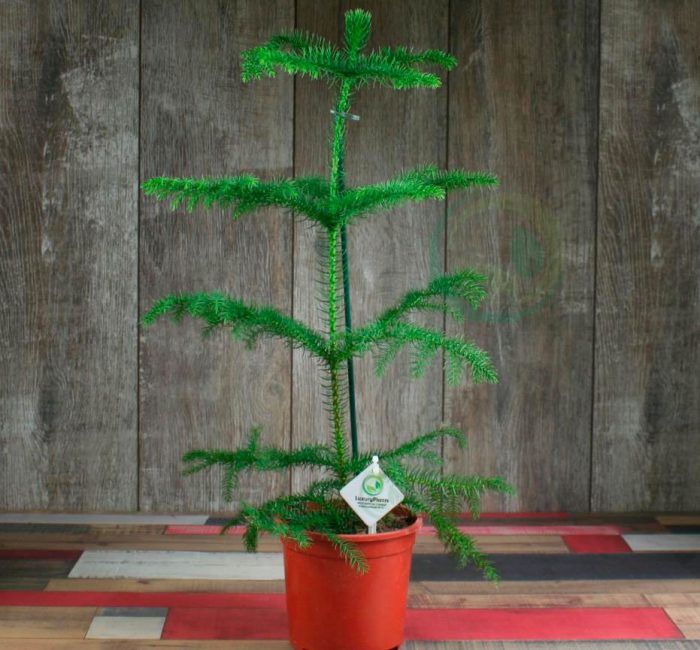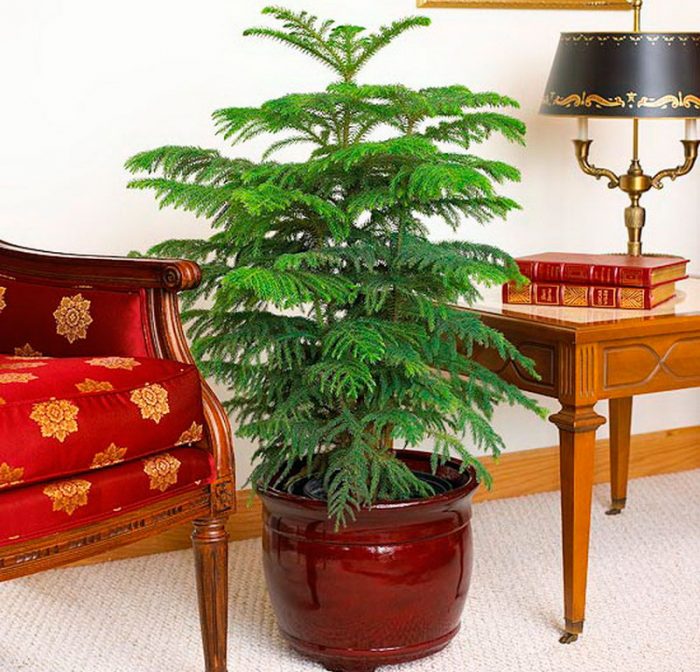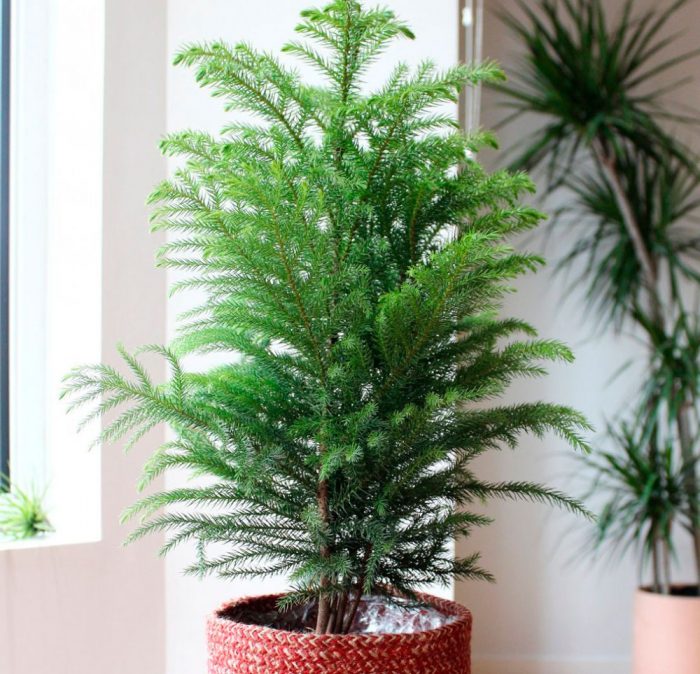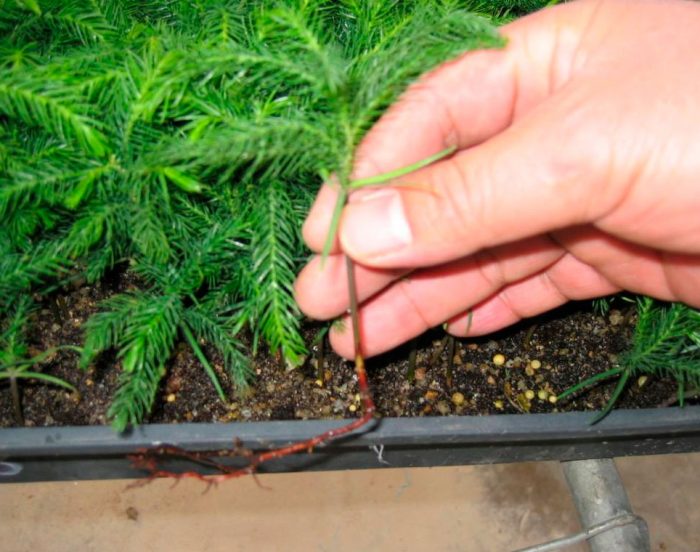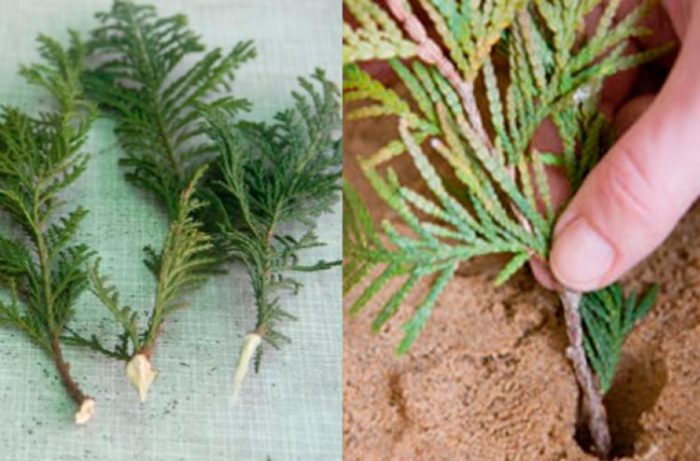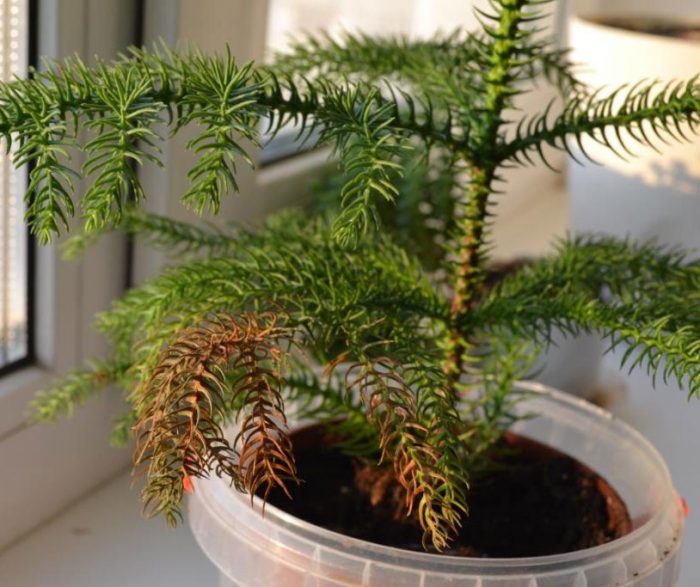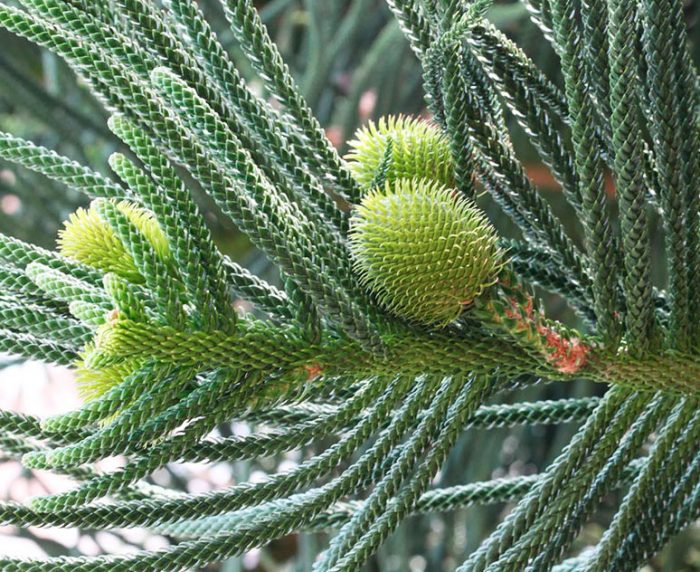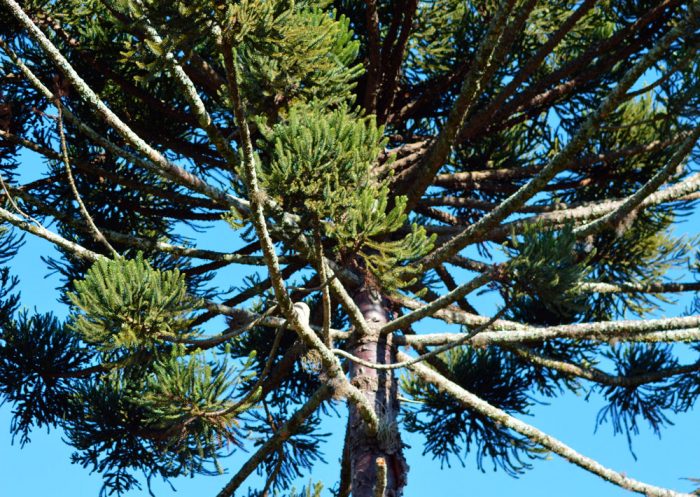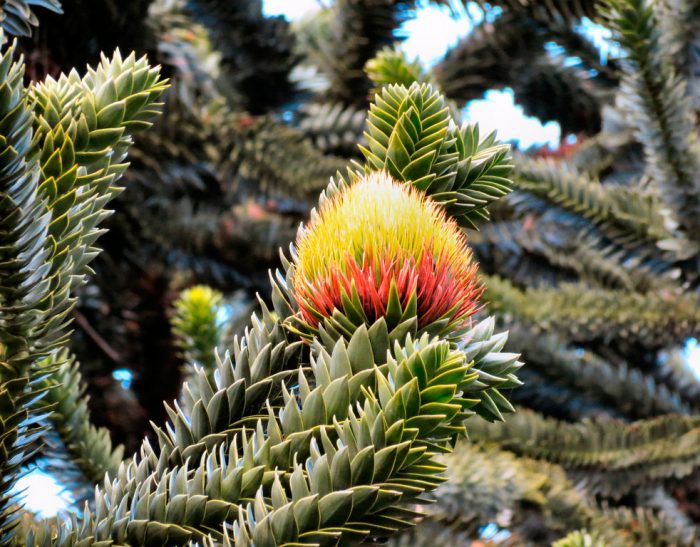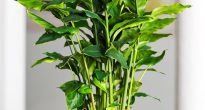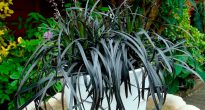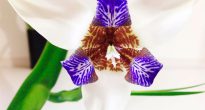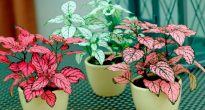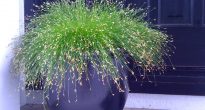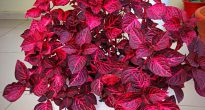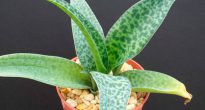The genus of plants Araucaria, belonging to the Araucariaceae family, has approximately 14 species. A plant native to Australia and South America. Araucaria is a coniferous plant that has hard, needle-shaped leaves. Its seeds can be eaten, while wood is used to make furniture.
Some of the araucaria species are cultivated as an ornamental plant near the Black Sea coast in the Caucasus. This tree is quite difficult to cultivate in the low humidity that is observed in most apartments, it grows best in greenhouses. With improper care, it gets sick, and sometimes this leads to its death. Araucaria is one of those conifers that can be cultivated indoors. It is grown as an ornamental deciduous plant, because it blooms extremely rarely at home. Araucaria is grown in compositions in winter gardens or in pots. Like all other conifers, it is able to purify the air.
Content
Brief description of cultivation
- Bloom... Araucaria is cultivated as an ornamental deciduous plant; it blooms very rarely under indoor conditions.
- Illumination... A tree needs a lot of bright light, which must be diffused.
- Temperature regime... In the warm season not higher than 20 degrees, and in the winter months - from 10 to 15 degrees.
- Watering... During the growing season, watered abundantly, and in the cold season, the substrate is moistened only after it dries out to 2/3 of the depth.
- Air humidity... It should be high, so the tree is often and regularly sprayed with a spray bottle.
- Fertilizer... During the growing season, fertilizers are applied to the substrate once every 15 days. To do this, take a complex mineral fertilizer with a low calcium content.
- Dormant period... It begins in late autumn and ends with the onset of spring.
- Transfer... The procedure is carried out in spring or in the first summer weeks. Young bushes are transplanted only after their roots cease to fit into the container, and older ones - once every 3 or 4 years.
- Soil mixture... It should include peat, sand, leaf and turf soil (1: 2: 1: 2).
- Reproduction... By cuttings and generative (seed) method.
- Harmful insects... Mealybugs and aphids.
- Diseases... The bush can get sick due to improper care or inappropriate conditions.
Home care for araucaria
Illumination
Araucaria is a light-loving plant and needs a lot of bright light when grown indoors. However, it must be protected from direct sunlight. In the warm season, if you wish, you can move it outside, and you should choose a place that will be reliably protected from direct sunlight and precipitation.
It is best to put the bush in a place where the light will fall on it from two sides at once. In the event that the light falls on only one side, then in order for the crown to grow and develop evenly, the plant needs to be turned 90 degrees 1 time in 7 days.
Temperature regime
Indoor araucaria feels good only in the cool. During the summer, the air temperature should be around 20 degrees. In the cold season, it should be about 10 degrees, while the room should not be warmer than 15 degrees.
Watering
Throughout the year, well-settled water is used for irrigation. Make sure that the lump of soil in the pot does not dry out in summer, as this can damage the plant greatly. In this regard, in the warm season, watering should be systematic and abundant, but liquid stagnation in the root system should not be allowed. In winter, watering should be more scarce and less frequent, especially if the bush hibernates in the cold.
Air humidity
The plant must be regularly moistened from a spray bottle, for this use well-settled water (at least 24 hours) at room temperature. The foliage is moistened all year round, especially if the araucaria wintering takes place in a room in which there are working heating devices.
Fertilizer
During intensive growth, the plant is fed 1 time in 15 days and a solution of mineral complex fertilizer with a low calcium content is used for this, the concentration of which should be very low. Also, experienced florists recommend feeding it with mullein infusion once every 30 days.
Araucaria transplant
Araucaria transplant is carried out only if necessary after the root system becomes very crowded in the pot. And this procedure is performed in the first half of spring or early summer. This culture does not tolerate transplantation quite well, in this regard, it is recommended to transplant only well-grown bushes.
The transplant of adult bushes is carried out 1 time in 3 or 4 years, for this they use a wide pot, which is filled with a soil mixture consisting of peat, sod and leafy soil, as well as sand (1: 2: 1: 2). For this, you can also use a soil mixture consisting of sand, humus, peat, coniferous, deciduous and sod soil, which are taken in equal parts. Do not forget to make a drainage layer at the bottom of the container, which will prevent stagnation of water in the substrate. Araucaria can be grown hydroponically if desired.
Reproduction methods
Growing from seeds
Only fresh seed material of araucaria has good germination, so it cannot be stored for a long time. Fresh seeds are sown immediately into separate pots, which are filled with an earth mixture consisting of sod, leafy and peat soil, and also sand (1: 1: 1: 1). Or you can use a substrate consisting of sand and peat, to which very little fine charcoal is added. Crops are watered with a small amount of water, and their surface is covered with a thin layer of sphagnum moss. Provide the crops with systematic ventilation and humidification from a spray bottle, while the air temperature should be about 20 degrees.
You should not wait for friendly shoots, some seedlings may appear after 15 days, while others - only after a couple of months. After the root system of a young bush becomes very cramped in a pot, they are transplanted into a new, larger container.
Cuttings
For harvesting cuttings, the half-lignified upper branches of the bush are used. It is carried out in the first half of spring, while the cut is made a few centimeters below the whorl. The prepared cuttings are placed in a shaded place for 24 hours, then the resinous juice is removed from the cut and sprinkled with coal powder. In order for rooting to be successful, the lower part of the cuttings is treated with an agent that stimulates root growth. They are planted for rooting in separate pots, which are filled with a mixture of peat and sand (1: 1) or just sand. Cover the cuttings with a glass jar or a cut plastic bottle. The cuttings are placed in a warm place (about 25 degrees) and systematically ventilated and moistened with a sprayer. Cuttings that are warm will give roots after a couple of months, but if the room is cooler, then the rooting process can take up to five months.
When the roots of rooted cuttings become very cramped in the pot, they will need to be transplanted into larger containers, while the soil mixture is used the same as for growing an adult araucaria (see above).
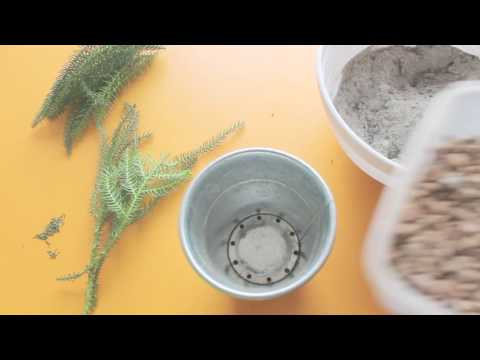

Watch this video on YouTube
Possible problems
If the araucaria is not properly looked after, then the following problems may arise with it:
- After pruning, the growth of the bush stopped... If the upper part of the araucaria was injured during pruning, then in the future its development will be incorrect or its growth will stop altogether. Provide the plant with enough bright light, make sure that the room is not too cold in winter, and do not forget that the humidity should always be high.
- The bush dries and crumbles... If the lighting is too poor, and the humidity is low, then the needles begin to crumble at the bush, and the stems dry up and turn yellow. If it is too hot in the room or stagnation of water is regularly observed in the substrate, then the branches of the plant begin to droop.
- The growth of the bush is very slow... Araucaria grows and develops slowly in the event that the soil mixture contains a lot of calcium.
- Very thin branches... Young branches will be too thin if the plant is not fed regularly.
- Harmful insects... Araucaria can harm aphids and mealybugs, as well as pests of conifers.
Araucaria species
Araucaria cook (Araucaria columnaris)
In nature, the species is found on Pine Island and in the tropical part of the southern New Hebrides. Short branches, gathered in whorls, grow from the trunk at an angle of almost 90 degrees. The crown usually expands at the apex. The length of the cones is about 10 centimeters, outwardly they look bristly, because they have an awl-shaped appendage drawn from top to bottom. The needles are soft, the narrowing of the upper part of the crown is very smooth. Most often this species is cultivated in subtropical and tropical countries.
Araucaria heterophylla (Araucaria heterophylla)
The plant comes from Norfolk Island, where it can reach a height of about 60 meters. The flaky bark is light brown. Due to the fact that the branches grow perpendicular to the trunk, the shape of the crown is pyramidal. Tetrahedral needle-like leaves are located on the branches in a spiral, they reach about 20 mm in length and bend slightly upward. Inexperienced growers often confuse this species with the tall araucaria (Araucaria excelsa).
Araucaria angustifolia (Araucaria angustifolia)
Or Brazilian araucaria (Araucaria brasiliana). The species grows in nature in the south of Brazil in its mountainous part. In nature, the height of a tree can reach 50 meters, and at home - no more than three meters. On hanging thin branches, linear-lanceolate leaf plates of a rich green color grow, reaching up to 50 mm in length. The wood of such araucaria is widely used in construction and in the furniture industry, and it is also used to make musical instruments and paper.
Chilean araucaria (Araucaria araucana)
Such a plant can be found in nature in the western part of Argentina, and also in Chile. The trunk can be up to 60 meters high and its diameter can be up to one and a half meters. Longitudinally spaced cracks cover the resinous thick bark. As a rule, the lower branches lie on the surface of the soil and over time they die off. Lateral branches are collected in whorls of 6–7 pieces. In middle-aged plants, such branches grow perpendicular to the trunk, and in older trees they hang slightly. Spiny and tough dark green leaf plates on the branches are arranged spirally and very densely. Healthy and delicious seeds can be eaten. Wood is widely used in construction.


Watch this video on YouTube

